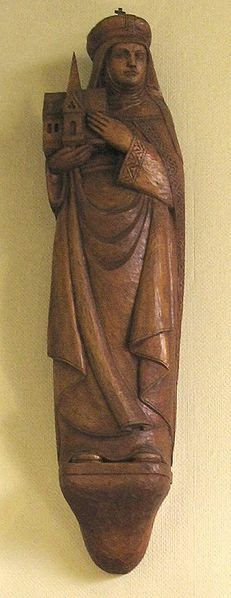 |
| Snowy owl. Creative Commons image by Matt MacGillivray |
 |
| Hedwig, Queen of Poland. Public domain image |
Hedwig married Henry I, nicknamed Henry I the Bearded. Henry I is remembered for bringing the German language and culture to Silesia.
Henry I became Duke of Silesia in 1232, a position he held until his death in 1238. Their son Henry II the Pious became Duke of Silesia upon his father's death, and Hedwig spent the remainder of her life in a monastery (which she'd encouraged her husband to establish) as a lay sister. She did not become a nun. When Henry II died, Hedwig and Henry II's widow Anna of Bohemia (sometimes called Anne of Bohemia) established a Benedictine abbey together.
Besides founding several religious institutions with her husband and daughter-in-law, Hedwig of Silesia is known for her charity and humility. She refused to wear shoes, even in winter. She ministered to women afflicted with Hansen's disease. In folklore, she is also credited with stopping in Austria on a pilgrimage to Rome; where she visited Austria, a stream with healing properties sprung up from the earth.
 |
| St. Hedwig of Silesia, public domain image by Matthias Feige |
Robert Spiske is not himself considered a saint, but the Catholic church considers him "venerable." He was a Polish priest born in 1821, known for his preaching, pastoral work with young people, and outreach to people who felt alienated from the church.
According to TheHogsHead.org, a Harry Potter fan website, Hedwig of Silesia was the mother of seven children, like Molly Weasley. Her husband's name, Henry, is another form of the name Harry. The Hog's Head also reminds us that in the books, Harry chooses Hedwig's name after seeing it in A History of Magic by Bathilda Bagshot. We don't know what the fictional Bathilda Bagshot wrote in her fictional magical textbook, but it may have had something to do with those magical healing waters.
You can read more about St. Hedwig on Wikipedia and the Catholic Encyclopedia. The Catholic Encyclopedia lists her feast day as October 17. She is thought to have died on October 15, 1243.
Other saints' day posts you might enjoy:
St. Swithen's Day
St. Lucia's Day

Social Media, Writing, and Editing Services I Offer - Erin O'Riordan
No comments:
Post a Comment